Last week, we welcomed our first visitors to Lyon. My friend Kat, who graduated a few years after me from our alma mater, has been doing her masters in journalism in Paris. Out of the (somewhat) blue, she messaged me to say that her mother was visiting her, and wanted to see another city in France. Was that couch of ours still available? Of course it was! We had a great two days hanging out with Kat and her mother Michelle and took the chance to see one of the parts of Lyon that we hadn’t yet visited.

Here’s Lyonnais Geography and History 101: the city of Lyon is divided by two rivers, which flow from the north and merge together in the south. On the east is the Rhône River, and we live on its east bank, right next to Parc de la Tête d’Or. In the middle of the two rivers is the hill of Croix-Rousse and Presqu’île. To the west runs the Saône, and on its west bank that (in other words, clear on the other side of the city from us) is Vieux-Lyon and the hill of Fourvière. (If you are super confused about this geography, check out this map of Lyon.) The two hills of Fourvière and Croix-Rousse are historically (and respectively) contrasted as the hill that prays and the hill that works, because Fourvière is home to the Basilica of Fourvière, and Croix-Rousse was home to the silk workers who made this city an industrial center of their trade in the 19th century. Fourvière is coincidentally also where the oldest part of Lyon can be found, the remains of the town of Lugdunum, capital of the Roman province of Gaul (modern-day France). And if you ever took more than three years of Latin, you will know that Gallia est omnis divisa in partes tres.
In the afternoon, we picked up Kat and Michelle from the bus stop at Perrache, on the Presqu’île. They were in pretty good shape after a six-hour bus ride from Paris, minus an hour’s stop for lunch! (The French take their mealtimes pretty seriously.) We headed right up across the Saône River and hiked up the hill of Fourvière. We had selected an excellent day, and we took some time to eat some apples and admire the setting atop the remains of some Roman ampitheatres.
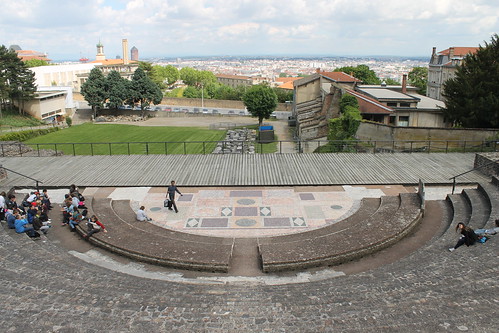
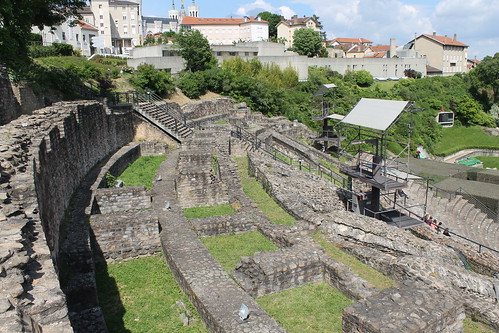
We then moved on to the Basilica of Fourvière, which is truly one of the hugest and most ornate cathedrals I have ever seen, just absolutely soaring vaulted roofs and gilded in gold everywhere you look. It has a very interesting Byzantine influence in its art — its walls are encrusted with mosaics, which bear a certain resemblance to Orthodox Christian art. The really astonishing thing is that there are two chapels, one on top of the other, in the Basilica. The bottom one holds a number of Madonnas and icons from around the world, like Our Lady of Guadalupe and the Madonna of Loretto.
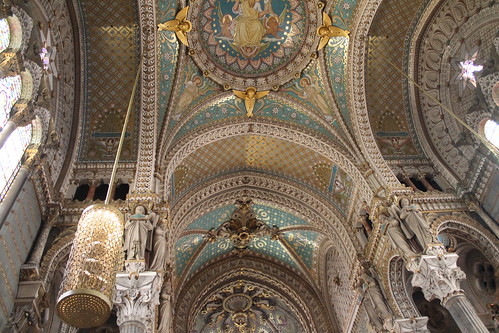
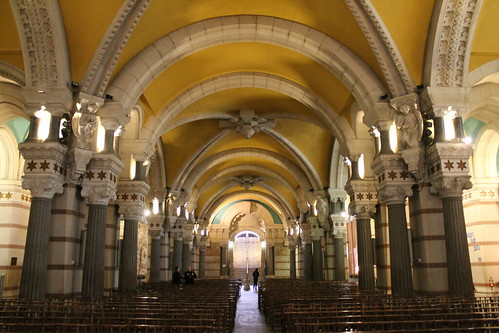
The best part about it, though, was the view. From the back of the basilica, you can see the most stunning view of Lyon. And on this sunny afternoon, it was just beautiful. The four of us spent a good ten-fifteen minutes gawking over it. Steve and I were pleasantly surprised to recognize so many landmarks; truly, this is not a huge city. You can walk halfway across it in less than 45 minutes, and it’s very pleasant to do so, as long as you’re not on either of the two hills.
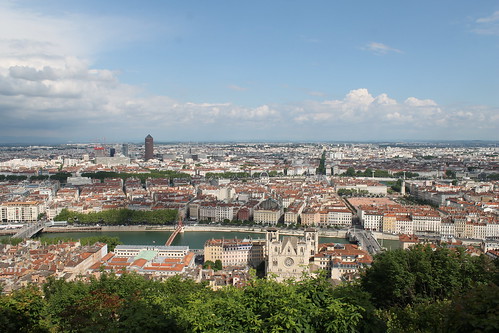

We took a winding road down to Vieux Lyon, the oldest, most Renaissance portions of Lyon. It also happens to be the most touristy these days, all cobblestone roads and very quaint buildings. We dove into one of the traboules there, these passageways composed of walkways and courtyard between buildings. They’re not quite secret, but they’re hidden from the street. We had to be quiet, though, since these courtyards transmit sound easily, and they’re all fully inhabited. Historically, Vieux Lyon and Croix-Rousse both have traboules. Those on Croix-Rousse were well-used by silk workers who wanted to transport their goods on the down-low, and I’m excited about investigating those at some point. Finally, we took the metro back to our apartment, and called it a night.
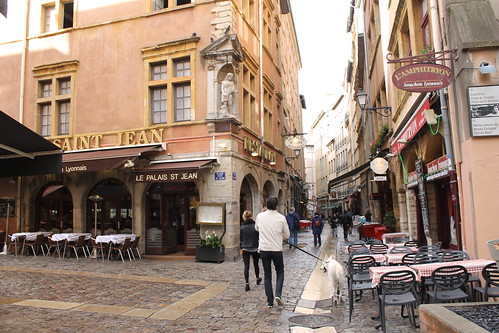
The next day, we got a late start out of the apartment, and went to investigate more of the Parc de la Tête d’Or. It’s five minutes away, and is definitely one of our favorite parts of Lyon. The free zoo and botanical garden can only help! We wandered around the greenhouses, and also peeked at some of the flamingoes, giraffes, and longhorn cattle before we parted ways. Kat and her mother explored Croix-Rousse in the afternoon, while Steve and I caught up on work. That evening, they had to catch an 11 pm bus back to Paris, but before then, we were going to treat ourselves to a classically Lyonnais meal at a genuine bouchon. The bouchons are historically working-class restaurants, and represent very typical local fare, which is pretty hearty and rich. We booked a table for four at Chez Mounier, which I had read a little about online. According to reviews, it served good food, and was great value for the price, but the service was wanting. We had no idea.
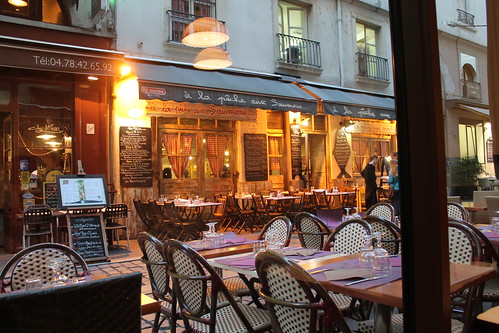
When we arrived at 8:30 pm sharp, it took us half an hour to be seated and to be given menus. We all ordered different selections for our four-course meal from the 14 euro menu, but it took nearly another half an hour before our first course came. I ordered the salade lyonnaise, which is bacon bits and croutons over salad with a poached egg on top. Other than feeling like I’d consumed my cholesterol for the month, it was really delicious. We had a good time discussing the French food and sharing our entrees with each other. For our second course, I got a pork chop with vegetables, and Steve got andouillette, which is sausage made of tripes. It was received without enthusiasm, to say the least.
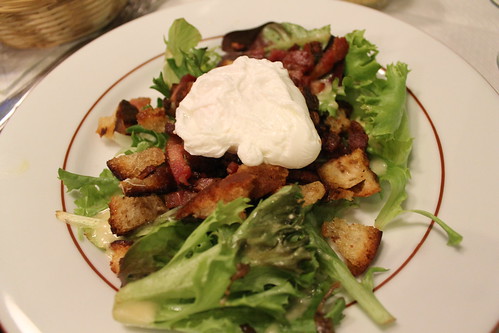
By that time, it was already ten, and Kat with her fluent French tried to convey in the least offensive way possible to the owner who was serving us that she hoped our cheese and dessert courses could come faster so they could make their bus at eleven. The owner did the best impression of a severely insulted hen, and shook her finger at Kat, telling her that everything was made fresh when ordered, after all. It made matters worse when Kat and Michelle selected fromage blanc for their cheese course, which is more or less very rich yogurt. They didn’t manage to finish their portions, though I would have tried to help if we knew what was coming! When the owner saw their dishes, she started just shaking her head and muttering about the “gaspillage” (waste) of it all, tut-tutting with a vigor. It was rather mortifying for Kat, but the rest of us were more amused by our very authentic bouchon experience.
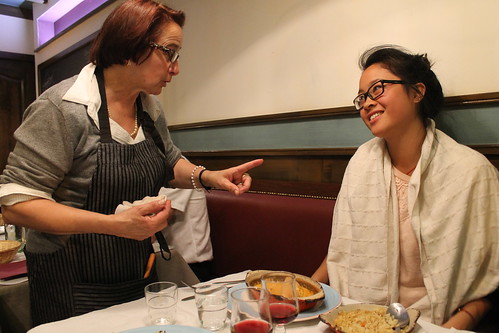
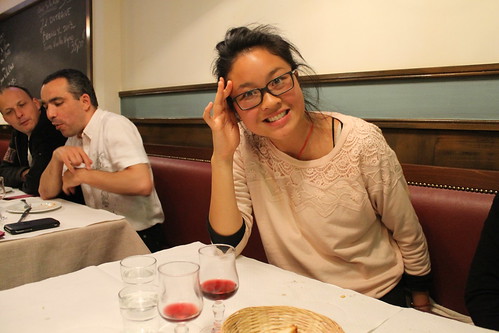
Finally, we each had a slice of cake or tart, and by the time we walked outside, we felt like we would not be hungry again for days. We said a hurried goodbye, though Kat will see us again when we come to Paris, and Steve and I walked home under a very full, orange harvest moon.
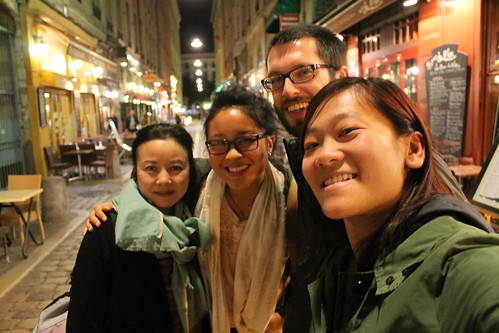
Overall, I think having visitors was a success, and we had a great time with Kat and Michelle. I am very much looking forward to other visitors in June, including perhaps even my own mother! Finally, Steve and I had a great talk with his parents last night over Skype, and it’s come to our attention that we have some followers in South Carolina. We love that you have been reading, and we hope it’s been a fun ride for you too! Feel free to leave a note about what you’d like to hear more about in the future or any questions. We’re having a ball, and we want to share as much of our time as possible.
Bisoux!
Connie
I relished the story of the restaurant owner who tut-tutted Kat! It seems so typical of how we view the French! And Steve… tripe? What would the restaurant owner done if you’d returned it because you didn’t like the taste! AMERICANS! sheesh…..